[Tavel report from Eva Kiene (Rapunzel press officer)]
A fresh seabreeze welcomes us as we are landing in the town of Chania on Crete. On Crete, my colleague from the purchasing department, Petra Mayr-Graf and I are visiting some of the farmers who grow the organic olives for Rapunzel's Cretan olive oil. We want to find out how the special quality of this olive oil is made, all the way from the field to the bottling process. Instead of the expected mild Mediterranean climate, we are greeted by rather cool temperatures that follow a stormy and rainy period. But now, the fields have dried and the olive harvest is about to start.
A fresh seabreeze welcomes us as we are landing in the town of Chania on Crete. On Crete, my colleague from the purchasing department, Petra Mayr-Graf and I are visiting some of the farmers who grow the organic olives for Rapunzel's Cretan olive oil. We want to find out how the special quality of this olive oil is made, all the way from the field to the bottling process. Instead of the expected mild Mediterranean climate, we are greeted by rather cool temperatures that follow a stormy and rainy period. But now, the fields have dried and the olive harvest is about to start.

An idyll on the mountain
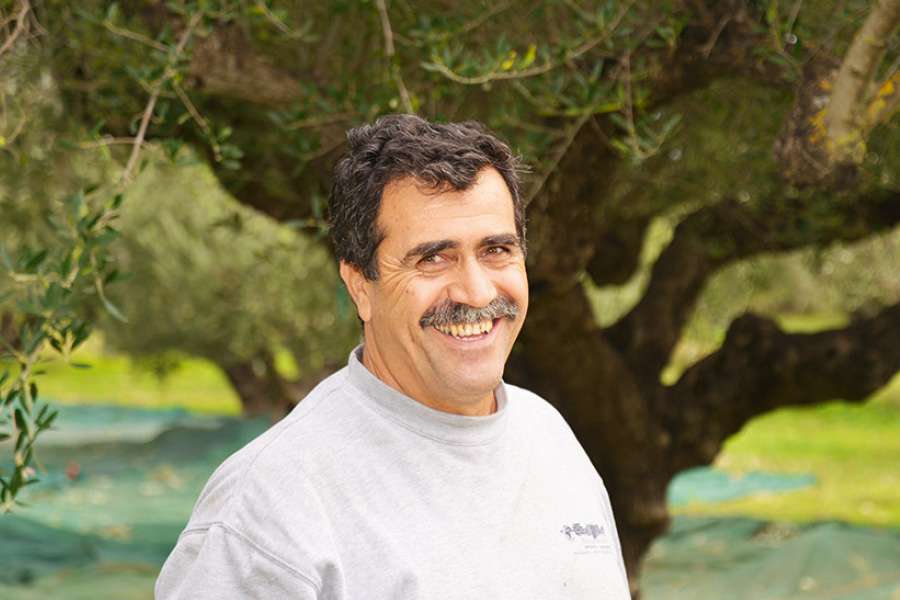
Dimitris Katzaros is one of the farmers who cultivates organic olives for Rapunzel
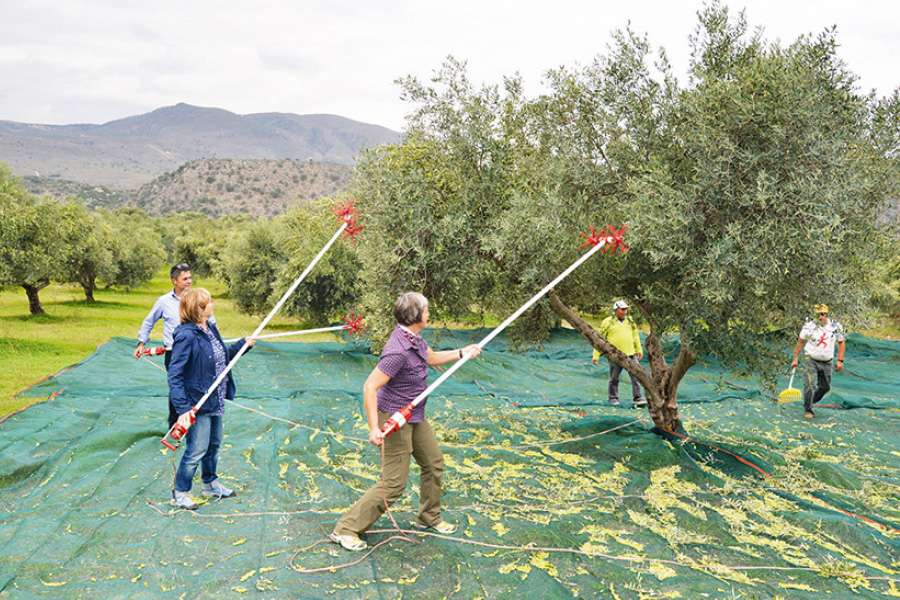
The manual yield is hard labor
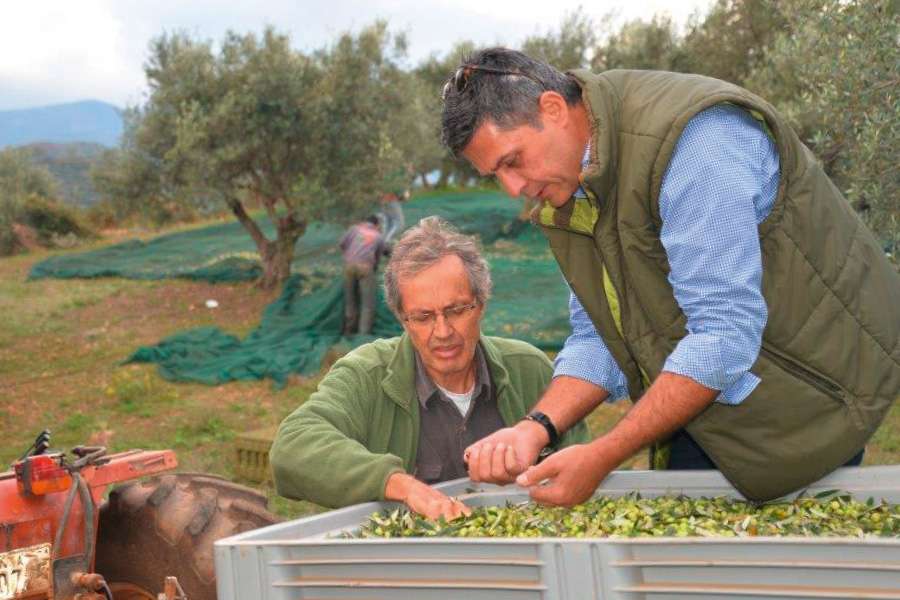
Mixalis Marakas and Charamblos Doukakis inspect the harvested olives and are very happy with this year's quality
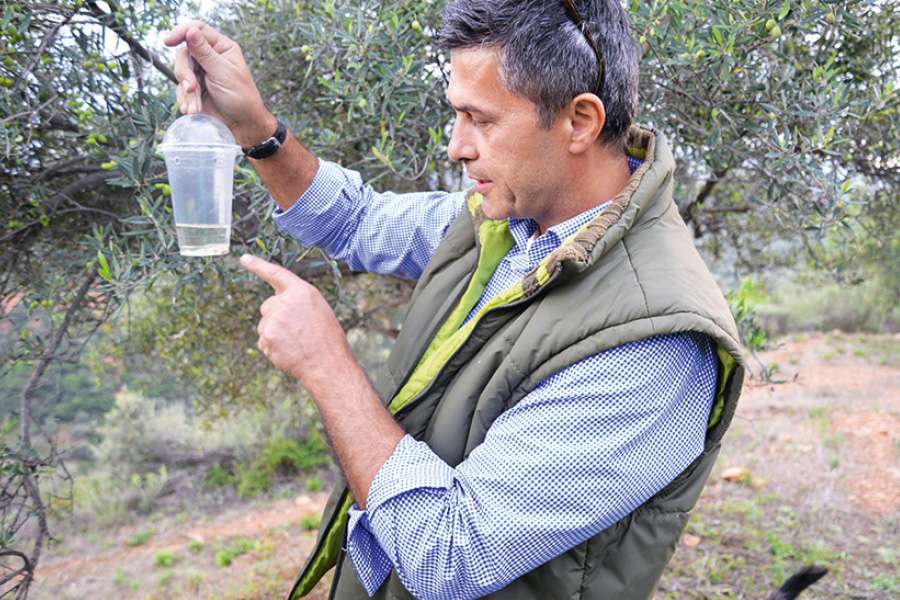
The agricultural adviser Charalambos Doukakis explains his "fly-go-away" method
End of October 2015 – finally Dimitris Katzaros and his helpers are able to pick the olives. Until a few days ago, it was still raining. For the harvest, both the soil and especially the olives should be dry. Otherwise it would be bad for the olive oil quality. Dimitris has been working with the same harvest hands for years and they are a well-tuned team. Carefully, they pick the olives with their electric manual rakes. The olives fall undamaged into the harvest nets that are spread out on the ground. After the olives have been picked, the workers carefully fold the nets and fill the fruits into small, stackable crates while constantly paying attention not to step on the olives. The olive groves are extensive and green; every individual tree has enough room to flourish. Several small details on the field have a decisive influence on the olive oil quality: soil quality, thorough tree maintenance, the pruning of the trees and the protection against pests.
At Mixalis Marakas, the olive harvest is also under way. In order to get to his extended olive groves, we drive on a bumpy path higher up into the mountains. There the olive trees are idyllicly embedded into the landscape; the terraced olive groves almost look like a painting. Mixalis is a true organic pioneer. Already in the 1980s, he converted to organic agriculture. With this year's harvest and quality, Mixalis can be very happy, especially since last year's yield was relatively poor.
His olives are relatively big and the much-feared olive fly hardly harmed them. Mixalis is testing a method that was developed by the agricultural adviser Charalambos Doukakis: transparent coffee to go cups are filled with fly attractant and hung into the trees. This method has several advantages over ready-made, commercially available insect traps: the traps can be reused several times, are cheaper and serve as an insect monitoring gadget.
His olives are relatively big and the much-feared olive fly hardly harmed them. Mixalis is testing a method that was developed by the agricultural adviser Charalambos Doukakis: transparent coffee to go cups are filled with fly attractant and hung into the trees. This method has several advantages over ready-made, commercially available insect traps: the traps can be reused several times, are cheaper and serve as an insect monitoring gadget.
The farmer can see the fly infestation at one glimpse. He can react accordingly and spray the trees with rock flour, such as zeolite or kaolin. This mineral protectant is used in organic olive cultivation and has mechanical and optical effects on the pests. After a treatment, neither the fruits nor the leaves are no longer attractive for the olive fly.
Mixalis is a real tinkerer and eco-freak. Instead of gasoline powered harvest machinery, he uses electrical manual rakes that are powered by a car battery that he mounted on a self-made carriage so he could also charge the rakes in the mountains. In his shop, he develops practical tools that are good for the environment and for the olive quality. Mixalis also constantly optimizes his oil mill that complies with the highest qualitative requirements. Thanks to the short distance from the field to the mill, the olives are pressed immediately after they were harvested.
Mixalis is a real tinkerer and eco-freak. Instead of gasoline powered harvest machinery, he uses electrical manual rakes that are powered by a car battery that he mounted on a self-made carriage so he could also charge the rakes in the mountains. In his shop, he develops practical tools that are good for the environment and for the olive quality. Mixalis also constantly optimizes his oil mill that complies with the highest qualitative requirements. Thanks to the short distance from the field to the mill, the olives are pressed immediately after they were harvested.
The right time / cool temperatures in the mill
In order to obtain first-class olive oil, the farmers have to harvest at the right time. If the olives are too ripe, the farmers will get a higher yields, but the olive oil quality will deteriorate. Another important aspect for preserving valuable plant components in the oil is the time it takes until the harvested olives are transported to the oil mill. Therefore, the oil mill is located at a short distance from the olive groves. Additionally, the farmers from the Cretan project also pay attention to handle the olives very carefully after they were harvested. Small yield boxes guarantee that the olives will not be damaged from their own weight. All this is important for preserving valuable ingredients such as antioxidants and polyphenols as best as possible.
In the oil mill, all remaining leaves are removed and the olives are washed. The washed olives are ground in a hammer mill. Subsequently, the olive pulp is kneaded in a mixer for a predefined time. The kneading process unfolds the aroma and first oil droplets will form. Next, the decanter separates the solids from the liquid mass. Finally, a centrifuge separates the valuable oil from aqueous olive components. It is important that the processing temperature wil stay significantly below 27 degree. The finished, dark-green olive oil flows from the centrifuge, smelling very fresh and grassy.
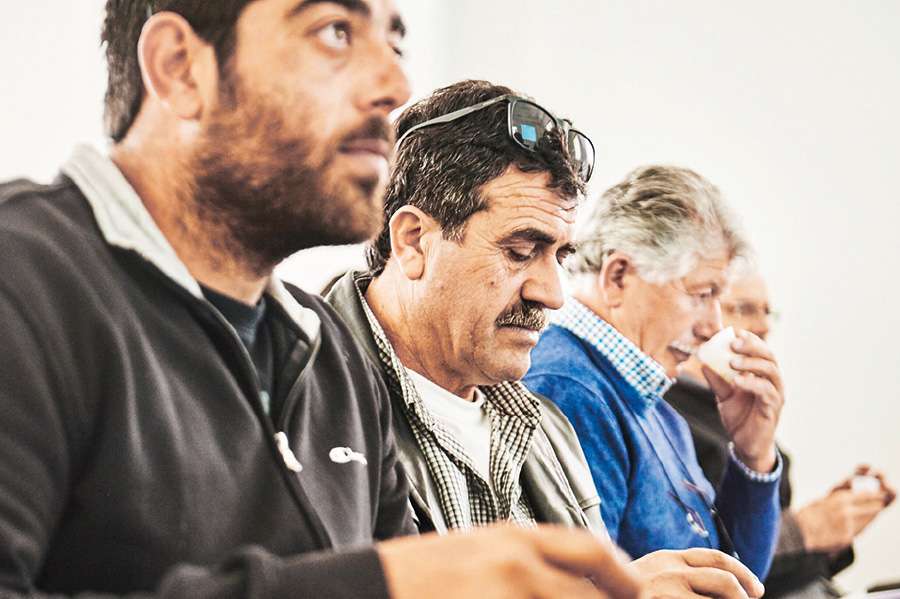
Regular farmer trainings on agricultural topics but also on sensory issues ensure a continuous, first-class product quality
From the oil mill to the bottling process
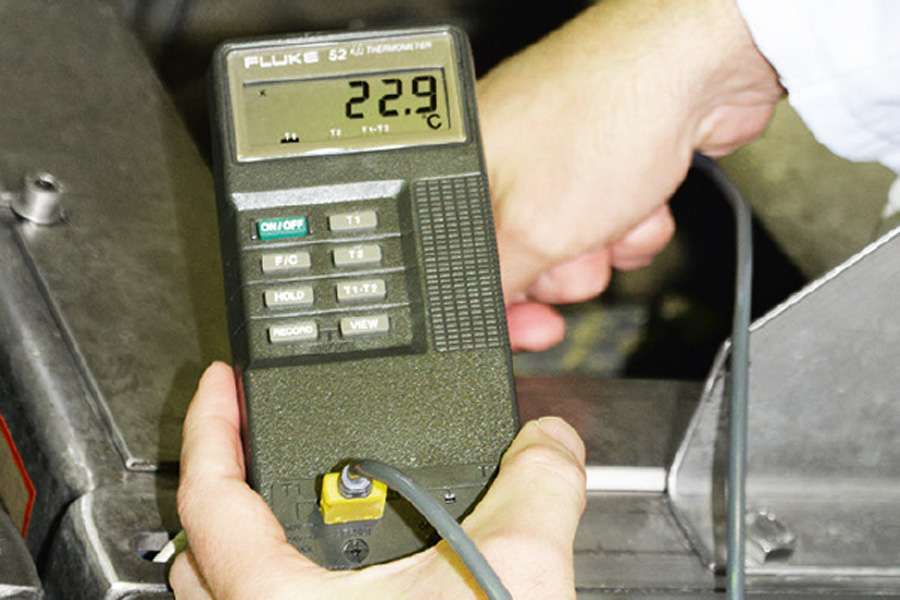
The temperature should stay below 27 degree throughout all the processing steps in the mill
Every farmer uses for his olives separate containers, so-called cubitainers. Only when the olive oil analysis confirms a perfect and high product quality, the oil will be bottled.
Olive oil specialist Philipp Notter has equipped a small lab with state of the art technology. Next to a sensory evaluation, the most important quality parameters such as the amount of free fatty acids, polyphenols and tocopherols are determined via quick tests in his lab. From these measurements, first conclusions can be drawn before the detailed analyses from the external lab are available.
Olive oil specialist Philipp Notter has equipped a small lab with state of the art technology. Next to a sensory evaluation, the most important quality parameters such as the amount of free fatty acids, polyphenols and tocopherols are determined via quick tests in his lab. From these measurements, first conclusions can be drawn before the detailed analyses from the external lab are available.
For the the Rapunzel oil, separate tanks in a temperature-controlled storage room are used. These ambient conditions are also important for a continuous high quality. From these tanks, the liquid gold is filled into bottles before it is shipped to Germany.
All the processing steps take place in the region around Chania on Crete. A well-coordinated team ensures perfect quality: the farmers who work their fields very carefully and diligently. The agricultural adviser Charalambos who refines cultivation methods and advises the farmers. Olive specialist Philipp who supervises the processes in the mills and also the partner who is responsible for the bottling process strives for best quality even in this process step. We are sure you will enjoy the results!
All the processing steps take place in the region around Chania on Crete. A well-coordinated team ensures perfect quality: the farmers who work their fields very carefully and diligently. The agricultural adviser Charalambos who refines cultivation methods and advises the farmers. Olive specialist Philipp who supervises the processes in the mills and also the partner who is responsible for the bottling process strives for best quality even in this process step. We are sure you will enjoy the results!
Many steps for best quality
If olive oil has a good or a very good quality is not only decided in the oil mill. Until that final processing step, many small intermediate steps and a lot of diligence are needed.
What is important for excellent olive oil quality?
What is important for excellent olive oil quality?
- careful maintenance of the trees and the soil quality
- keeping the percentage of damaged or pest-infested fruits as low as possible
- harvest at the right time and avoid mechanical damage
- processing of clean olives without leaves or branches
- short distances and correct storage from the harvest until further processing
- clean processing and filling equipment
- cool temperatures and prevention of excess oxygen input during processing
- intermediate storage in stainless steel tanks under a protective atmosphere of 17-20°
Rapunzel Crete olive oil extra virgin P.D.O.
Nearly a dozen farmers, who are all located around the town of Chania, grow the olives for this popular olive oil. The harvest is particularly elaborate, as the olive trees often grow on steep slopes or on terraced groves. The farmers harvest the olives manually. Directly after the harvest, the farmers transport the olives to the nearby mill. Only when external analyses have confirmed a perfect olive oil quality, the olive oil is bottled.
Nearly a dozen farmers, who are all located around the town of Chania, grow the olives for this popular olive oil. The harvest is particularly elaborate, as the olive trees often grow on steep slopes or on terraced groves. The farmers harvest the olives manually. Directly after the harvest, the farmers transport the olives to the nearby mill. Only when external analyses have confirmed a perfect olive oil quality, the olive oil is bottled.
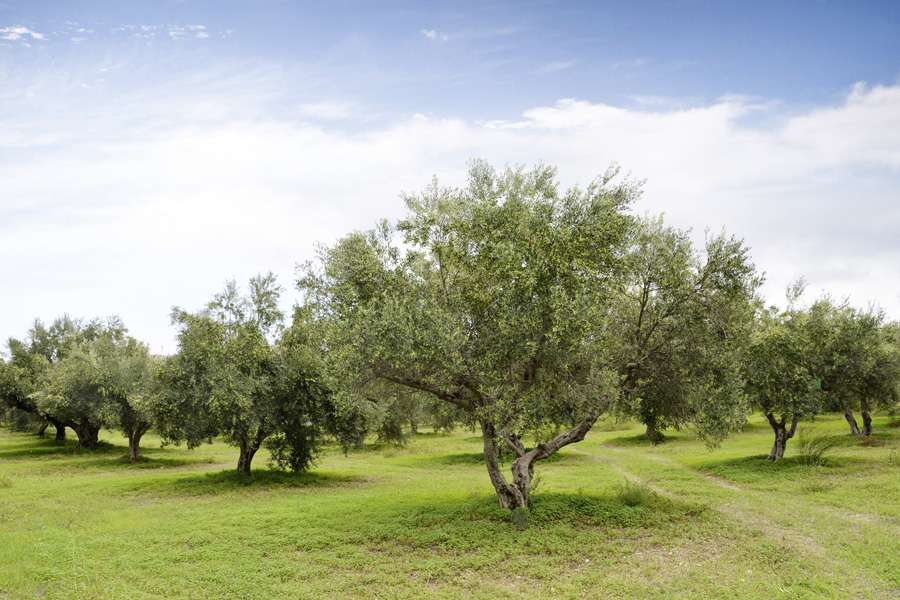
Soil fertility is an important factor for good olive quality. The farmers sow clover as undergrowth that also improves water absorption
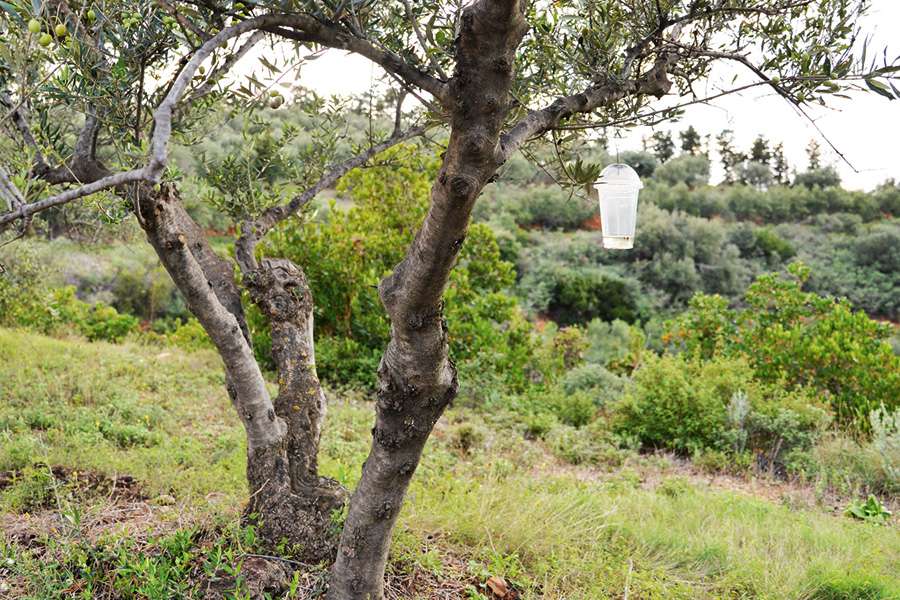
The olive fly is a feared pest. Here, the Cretan farmers try out a new method with coffee to go cups. This method is referred to as: fly-go-away
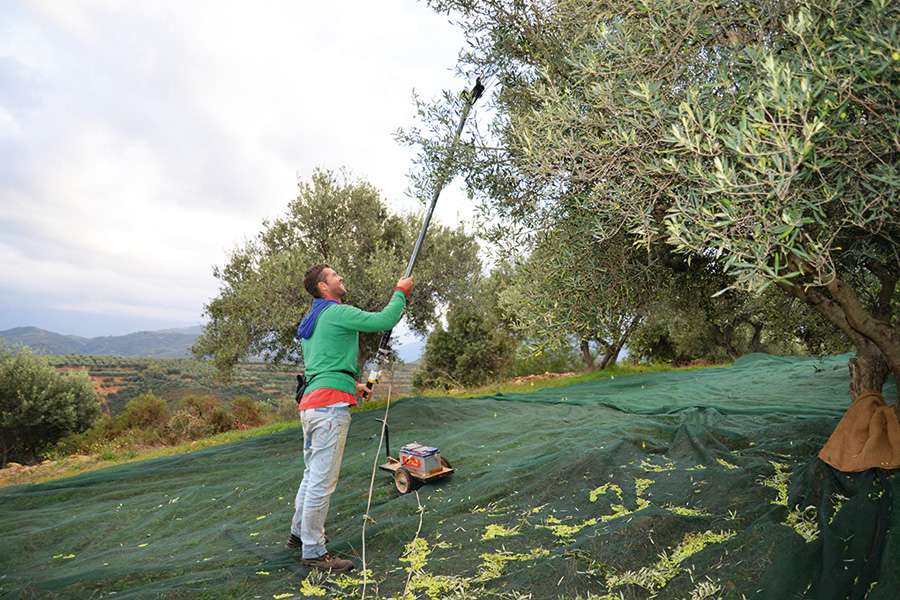
The harvest should not damage the olives. The harvest hands use special rakes and pay attention not to step on the olives
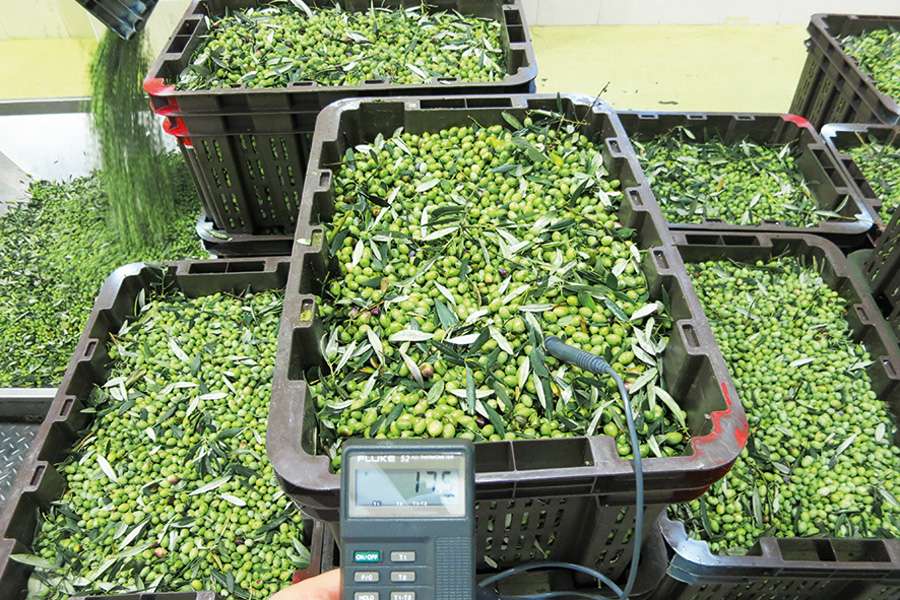
Harvested olives are collected in small, ventilated boxes. This reduces pressure that might damage the olives. The temperature is measured in order to determine if the olives were correctly stored and transported
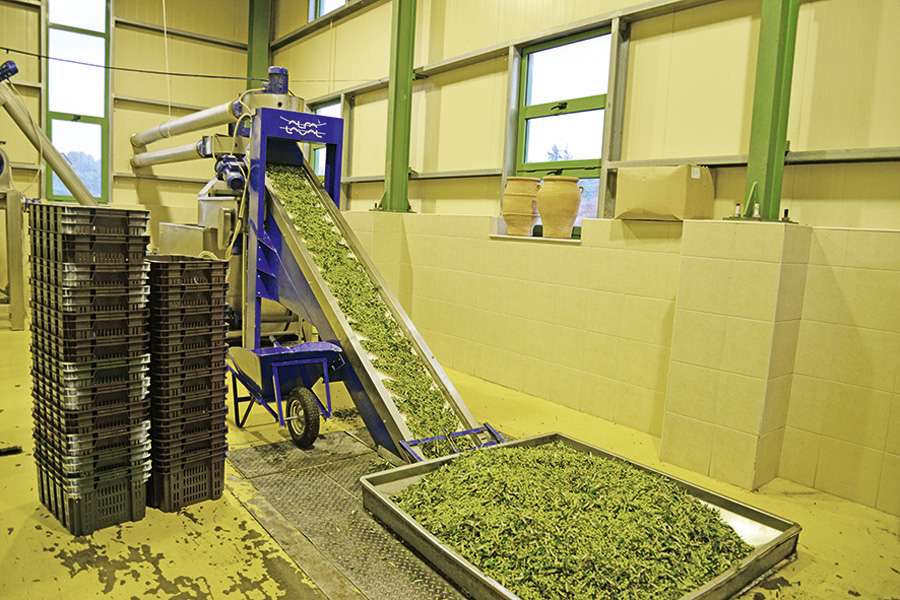
Prior to pressing, an air jet removes leaves and small branches
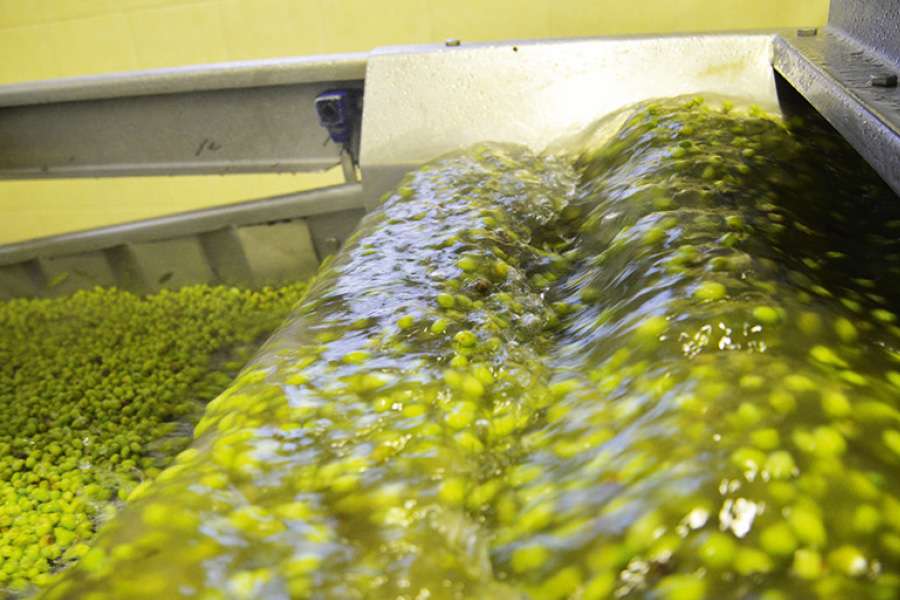
Next, the olives are washed before they are ground
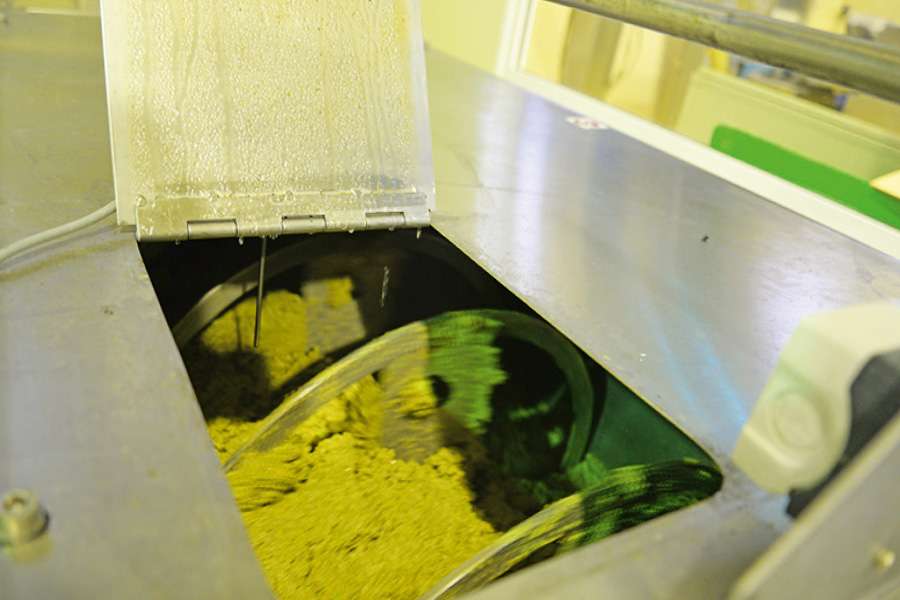
In the decanter, the solid components are separated from the liquid components. The oil flows from the pipe on the right into the centrifuge
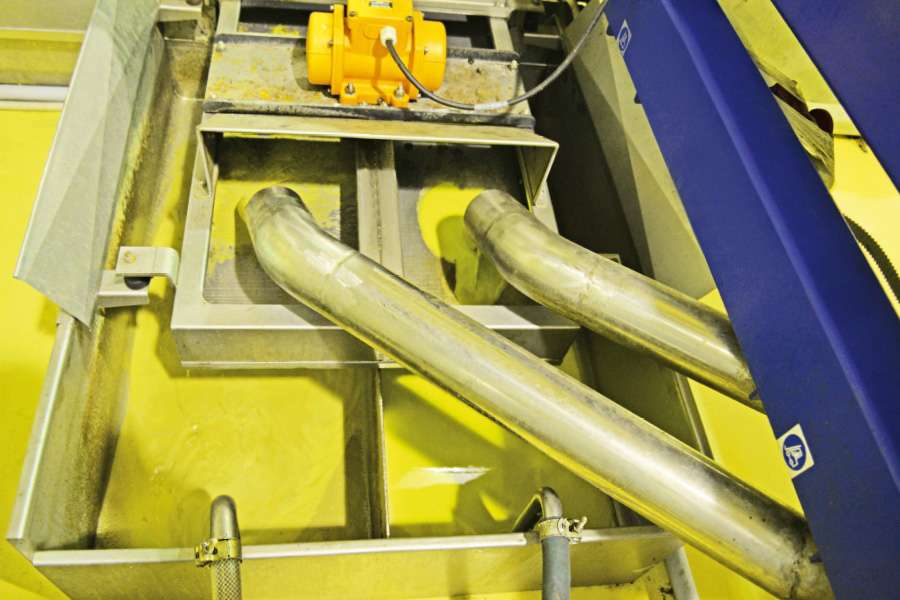
After the grinding, the olive pulp is kneaded for some time at low temperatures
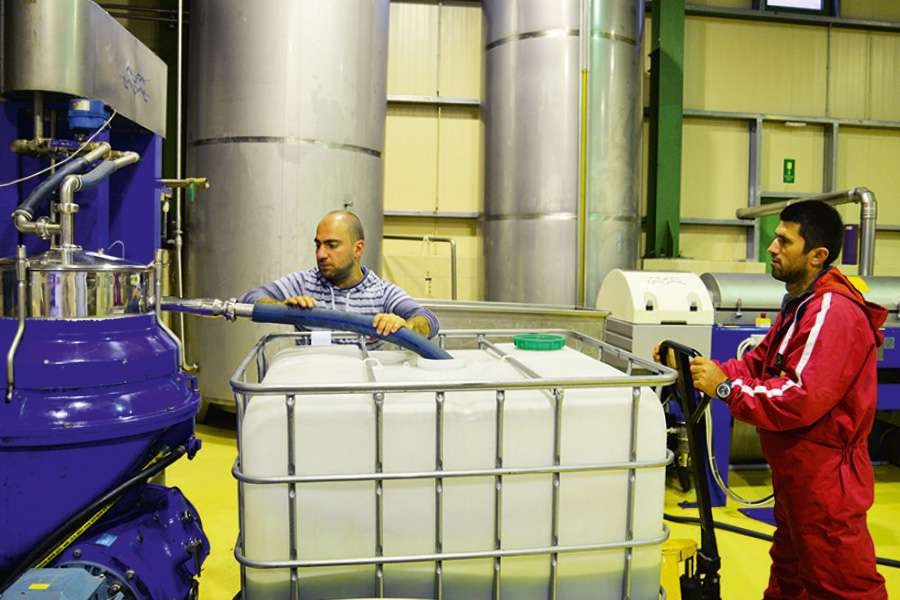
Fresh olive oil is filled directly from the centrifuge into plasticizer-free cubitainers. The oil is bottled when the analytical results are available
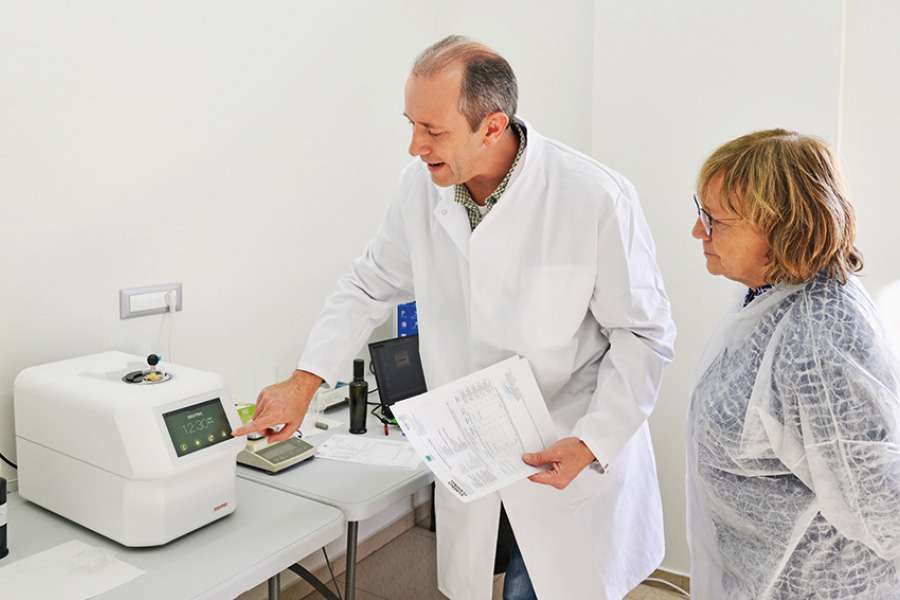
Philipp Notter explains Petra Mayer-Graf the near-infrared-spetrometer that provides first results of the oil quality
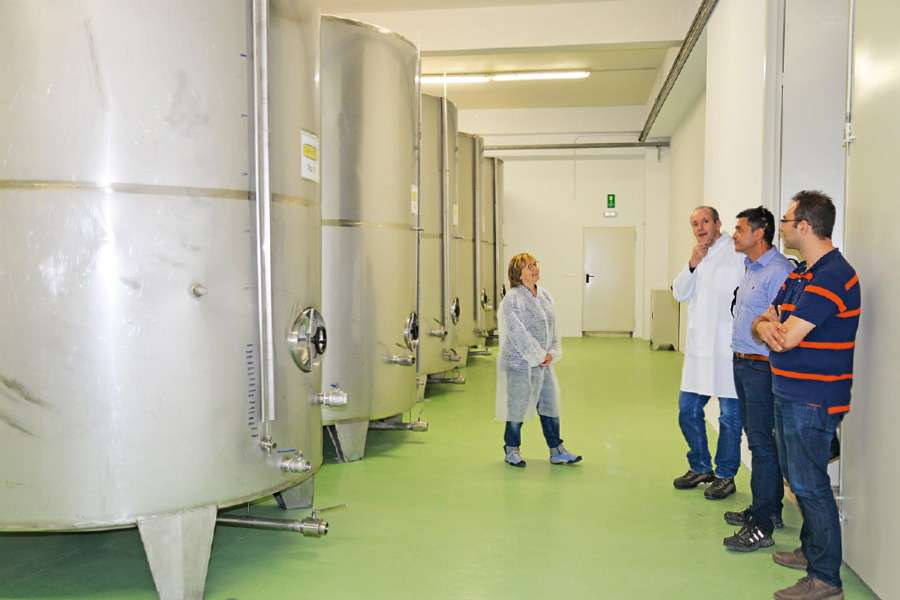
Rapunzel olive oil is stored under a protective atmosphere in air-conditioned rooms prior to being bottled
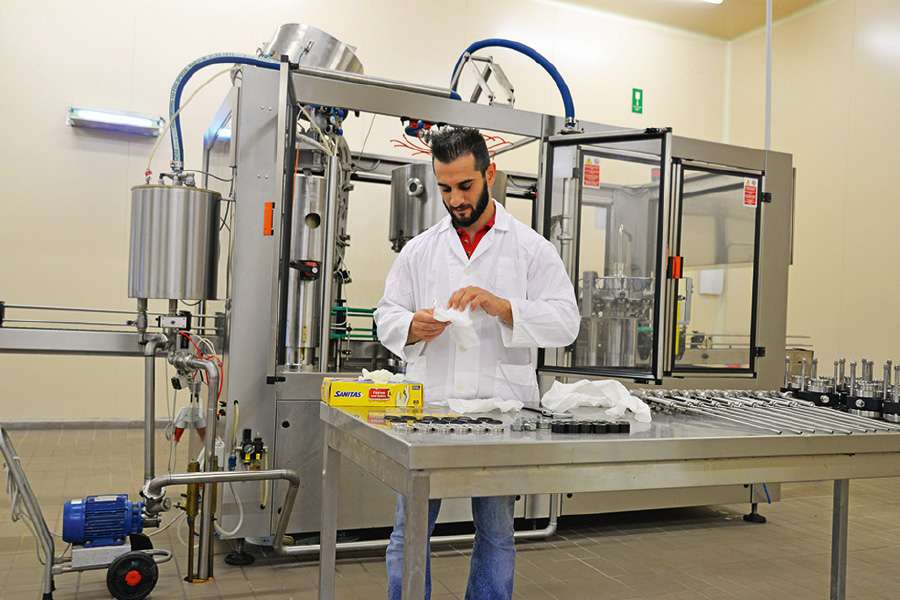
Prior to the bottling process, all parts of the filling machinery are thoroughly cleaned in order to avoid any negative effects on the quality
